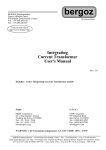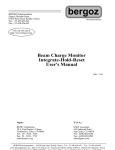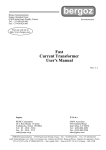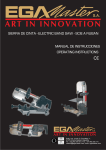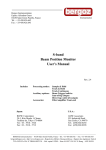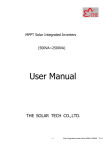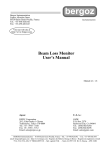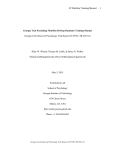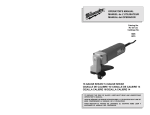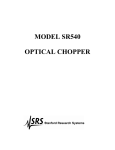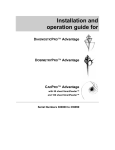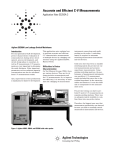Download BCM-IHR manual 2-2
Transcript
bergoz Bergoz Instrumentation Espace Allondon Ouest 01630 Saint Genis Pouilly, France Tel.: +33-450.426.642 Fax: +33-450.426.643 Instrumentation Visit our web site at http://www.bergoz.com Beam Charge Monitor (Modular Electronics) Integrate-Hold-Reset User's Manual Rev. 2.2 Japan: U.S.A.: REPIC Corporation 28-3, Kita Otsuka 1-Chome Toshima-ku, Tokyo 170-0004 Tel.: 03 - 3918 - 5326 Fax: 03 - 3918 - 5712 [email protected] GMW Associates 955 Industrial Road San Carlos, CA 94070 Tel.: (650) 802-8292 Fax: (650) 802-8298 [email protected] BERGOZ Instrumentation - 01630 Saint Genis Pouilly, France - Tel.: +33-450.426.642 - Fax: +33-450.426.643 email: [email protected] - http://www.bergoz.com - Registre des Métiers: Bourg-en-Bresse - Registre des ingénieurs: Zurich TVA-VAT-IVA-USt. Nº FR88414997130 - Sàrl. capital 152K€ - Siren 414 997 130 R.C.S. Bourg - APE 332B Record of updates Version Release date 2.1 February 12, 2008 p.6 p.7 p.8 p.15 2.2 Oscilloscope plot, trace 3 changed to “Output View”. Oscilloscope plot, trace 1 changed to “Signal View”. Oscilloscope plot, trace 3 changed to “Output View”. Oscilloscope plot, trace 1 changed to “Signal View”. Oscilloscope plot, trace 3 changed to “Output View”. Oscilloscope plot, trace 1 changed to “Signal View”. Trigger delay range specified: 350 ns ... 7.3 us. Ex-factory setting specified as 4 us. March 8, 2008 p.3 Refers the user to Annex II for AC Mains Voltage change Instructions Annex II Delta Elektronika U-Series Mains Voltage change Instructions BERGOZ Instrumentation 01630 Saint Genis Pouilly, France Tel. +33-450.426.642 Fax +33-450.426.643 Page 1 Beam Charge Monitor Integrate-Hold-Reset User's manual SUMMARY Page INITIAL INSPECTION ....................................................................................... WARRANTY ...................................................................................................... ASSISTANCE ..................................................................................................... SERVICE & RETURN PROCEDURES ............................................................ YOU JUST RECEIVED YOUR BCM ................................................................ QUICK CHECK ................................................................................................. Front panel ............................................................................................ Jumpers configuration for quick check .................................................. Set-up .................................................................................................... Waveforms ............................................................................................ Your BCM does not behave as described ............................................... Testing all other BCM functions ............................................................ GENERAL DESCRIPTION.................................................................................. Purpose..................................................................................................... System components.................................................................................. ARCHITECTURE.................................................................................................. OPERATING PRINCIPLE.................................................................................... Integrating Current Transformer............................................................... Fast Current Transformer........................... .............................................. Cable connection....................................................................................... Signal processing...................................................................................... Timing of the BCM-IHR ....................................................................... Beam Charge Monitor output................... ................................................ On-line calibration.............................. ...................................................... SENSITIVITY OF THE BCM-IHR....................................................................... Full scales................................................................................................. Most sensitive configuration..................................................................... Least sensitive configuration..................................................................... REMOTE RANGE and CALIBRATION SWITCHING.............. ........................ MAKING PRECISE MEASUREMENTS WITH THE BCM.............................. SETTINGS............................................................................................................. Front-panel potentiometers............ ........................................................... On-board potentiometers.......................... ................................................ SPECIFICATIONS................................................................................................ Beam Charge Monitor.................................................... .......................... Power Supply and Fuses............... ........................................................... CONNECTOR PINS ALLOCATION................................................................... DB9 male Remote Control connector....................................................... ACCESSORIES..................................................................................................... BCM Chassis........................................................................................... Card extender............................................................................................ INSTALLATION ON THE VACUUM CHAMBER............................................ Break in the vacuum chamber electrical continuity.................................... Vacuum chamber impedance..................................................................... Wall current by-pass and RF shield.......................................................... Thermal protection of the ICT................................................................... Keeping high harmonics of the beam out of the cavity.............................. Annex I. Annex II Delta Elektronika U-Series Linear Power Supply data sheet Delta Elektronika U-Series Mains Voltage change Instructions 2 2 2 2 3 4 4 5 5 6 9 9 10 10 10 11 12 12 13 13 14 15 16 16 17 17 17 17 18 19 20 20 20 22 22 23 23 23 24 24 24 25 25 26 26 26 27 BERGOZ Instrumentation 01630 Saint Genis Pouilly, France Tel. +33-450.426.642 Fax +33-450.426.643 Page 2 Beam Charge Monitor Integrate-Hold-Reset User's manual INITIAL INSPECTION It is recommended that the shipment be inspected immediately upon delivery. If it is damaged in any way, contact Bergoz Instrumentation or your local distributor. The content of the shipment should be compared to the items listed on the invoice. Any discrepancy should be notified to Bergoz Instrumentation or its local distributor immediately. Unless promptly notified, Bergoz Instrumentation will not be responsible for such discrepancies. WARRANTY Bergoz Instrumentation warrants its beam current monitors to operate within specifications under normal use for a period of 12 months from the date of shipment. Spares, repairs and replacement parts are warranted for 90 days. Products not manufactured by Bergoz Instrumentation are covered solely by the warranty of the original manufacturer. In exercising this warranty, Bergoz Instrumentation will repair, or at its option, replace any product returned to Bergoz Instrumentation or its local distributor within the warranty period, provided that the warrantor's examination discloses that the product is defective due to workmanship or materials and that the defect has not been caused by misuse, neglect, accident or abnormal conditions or operations. Damages caused by ionizing radiations are specifically excluded from the warranty. Bergoz Instrumentation and its local distributors shall not be responsible for any consequential, incidental or special damages. ASSISTANCE Assistance in installation, use or calibration of Bergoz Instrumentation beam current monitors is available from Bergoz Instrumentation, 01630 Saint Genis Pouilly, France. It is recommended to send a detailed description of the problem by fax. SERVICE PROCEDURE Products requiring maintenance should be returned to Bergoz Instrumentation or its local distributor. Bergoz Instrumentation will repair or replace any product under warranty at no charge. The purchaser is only responsible for transportation charges. For products in need of repair after the warranty period, the customer must provide a purchase order before repairs can be initiated. Bergoz Instrumentation can issue fixed price quotations for most repairs. However, depending on the damage, it may be necessary to return the equipment to Bergoz Instrumentation to assess the cost of repair. RETURN PROCEDURE All products returned for repair should include a detailed description of the defect or failure, name and fax number of the user. Contact Bergoz Instrumentation or your local distributor to determine where to return the product. Returns must be notified by fax prior to shipment. Return should be made prepaid. Bergoz Instrumentation will not accept freight-collect shipment. Shipment should be made via Federal Express or United Parcel Service. Within Europe, the transportation service offered by the Post Offices "EMS" (Chronopost, Datapost, etc.) can be used. The delivery charges or customs clearance charges arising from the use of other carriers will be charged to the customer. BERGOZ Instrumentation 01630 Saint Genis Pouilly, France Tel. +33-450.426.642 Fax +33-450.426.643 Page 3 Beam Charge Monitor Integrate-Hold-Reset User's manual YOU JUST RECEIVED YOUR BCM.... Check that the voltage corresponds to your mains voltage. The power supply voltage is indicated on a plastic label located on the power supply module front panel. If it does not correspond, go to Annex II: Delta Elektronika U-Series linear power supply AC Mains Voltage change Instructions to adjust the power supply to your mains. Then change the fuse and front-panel and rear panel plastic labels accordingly. QUICK CHECK You can check immediately that your BCM is working. This is what you need: • Beam Charge Monitor Integrate-Hold-Reset: At least one BCM-IHR-E electronics module and one BCM-RFC/xx chassis • DB9 Remote control key • Integrating Current Transformer (or Fast Current Transformer) • 4-channel oscilloscope with 100 MHz bandwidth or better. • Pulse generator capable of making the trigger pulse (≥30 ns, ≥2.4V, 1 kHz) You will also need short (4-8 ns) BNC cables and SMA-BNC adapters. Verify that this manual corresponds to your BCM version The Modular Electronics "Beam Charge Monitor, Integrate-Hold-Reset" (BCM-IHR) version is the object of this manual. It consist of at least one BCM-IHR-E electronics module and one BCMRFC/xx 3U x 19" chassis. This User's manual does not describe older BCM versions, housed in an ABS plastic enclosure. Those are described in other manuals: • Beam Charge Monitor, Integrate-Hold-Reset User's Manual, version 1.x.x. • Beam Charge Monitor, Continuous Averaging User's Manual, version 1.x.x These older versions consist of three modules in an ABS plastic enclosure, marked: • "C.A.C." for Charge Amplifier and Calibration • "BSP-CA" or "BSP-IHR" for Bunch Signal Processor • a Delta or Schroff power supply module These older configurations may include a Wideband Amplifier. DB9 Remote control key A "DB9 Remote control key" is supplied with the Beam Charge Monitor. It is a small auxiliary printed board attached to a DB9 connector. An 8-bit switch is mounted on the printed board. It must be plugged to the DB9 Remote control connector at the rear of the BCM to allow range switching and calibration range switching during tests. Switches A0...A6 are active. They correspond to Bits 0...6 of the remote control (See “Remote Range and Calibration Switching”, this manual). Position 1 corresponds to bit HIGH. Position 0 corresponds to bit LOW. Switch A7 is not connected. Bit 7 controls “Calibration Enable”. This 0 function can be enabled during tests by the BCM front panel switch. DB9 Remote control key REMOTE CONTROL 1 BERGOZ Instrumentation 01630 Saint Genis Pouilly, France Tel. +33-450.426.642 Fax +33-450.426.643 Beam Charge Monitor Integrate-Hold-Reset Page 4 User's manual Front panel Module BCM-IHR-E bergoz BCM Calibration On Off Cal. Delay Trig. Delay Cal. source Tw 100pC 10pC 1pC Signal View Output View Timing View Font panel WARNING: Jumpers configuration & Potentiometers settings Your BCM is in the "Ex-factory" configuration. Jumper and timing adjustments (potentiometers) have been configured according to your order. Do not change those settings until you are familiar with the Beam Charge Monitor. BERGOZ Instrumentation 01630 Saint Genis Pouilly, France Tel. +33-450.426.642 Fax +33-450.426.643 Beam Charge Monitor Integrate-Hold-Reset Page 5 User's manual Setup BCM-IHR-E To rear panel “BCM Input” 30ns - 2.4V - 1 kHz Oscilloscope Pulse Generator ICT (or FCT) Ch1 Ch2 Ch3 Ch4 To rear panel “Trigger in” Signal View Output View Timing View Trigger to synchronize oscilloscope Connect as shown on picture: ICT (or FCT) to "BCM Input" on rear panel. Insert "Remote Control" key in rear panel DB9 connector. Note: All Remote Control switches should be OFF. Make sure your AC mains voltage corresponds to BCM mains voltage. Connect BCM chassis AC input to the mains. Apply a 50-ohm pulse (>30ns, >2.4V, 1 kHz) to "Trigger in" on rear panel. Apply same pulse to oscilloscope input channel, to trigger oscilloscope. Set this oscilloscope input channel to high-impedance. Turn front-panel "Calibration" switch ON. Look at the signals with the oscilloscope, all channel inputs must be high-impedance. All View points are on the front panel BNCs. BERGOZ Instrumentation 01630 Saint Genis Pouilly, France Tel. +33-450.426.642 Fax +33-450.426.643 Beam Charge Monitor Integrate-Hold-Reset Page 6 User's manual Waveforms Reminder: The front panel "Calibration" toggle switch should be ON. The signals should look like this: First Integration Window Trigger delay Second Integration Window Note: Calibration pulse falls inside second window Signal View Shows internal calibration pulse Timing View Output View Trigger as applied to BCM BERGOZ Instrumentation 01630 Saint Genis Pouilly, France Tel. +33-450.426.642 Fax +33-450.426.643 Page 7 Beam Charge Monitor Integrate-Hold-Reset User's manual Waveforms (Cont'd) Exercising the module: Turn the BCM-IHR-E "Cal. Delay" 20-turn front panel potentiometer: It changes the delay between the trigger and the calibrated pulse. The calibrated pulse can be moved from the second window (the "adding" window) into the first window (the "subtracting" window). When the calibrated pulse fits entirely into the first (subtracting) window, it should look like this: Signal View Shows internal calibration pulse Timing View Output View Trigger as applied to BCM BERGOZ Instrumentation 01630 Saint Genis Pouilly, France Tel. +33-450.426.642 Fax +33-450.426.643 Page 8 Beam Charge Monitor Integrate-Hold-Reset User's manual Waveforms (cont'd) Adjust your oscilloscope time base to a slower sweep: 50 µs / div. It should look like this: Signal View Shows internal calibration pulse Timing View Output View Trigger as applied to BCM The complete BCM-IHR cycle is visible on the oscilloscope including the BCM output reset to zero. Explanation of the Timing View: The Timing View is a signal to help the user: a) adjust the beam pulse inside the integration window b) adjust the timing of his readout ADC or sampling voltmeter with the BCM output signal. The voltage levels of the Timing View are arbitrary. • Signal lowest level, at the beginning of the trace: Beam Charge Monitor is ready to receive a Trigger. • First step up: BCM has received Trigger, the Trigger delay is elapsing (4µs in ex-factory conditions) • Second step up: The trigger delay has elapsed, the first integration window starts. In ex-factory conditions it lasts 4 µs. During this window, the signal is summed in the output with a negative sign. It is the "Subtracting" window. • Next step is down: The first or "Subtracting" window has closed. The second window starts. In ex-factory conditions, this window has equal duration to the first window duration. During this window, the input signal is summed with a positive sign. It is the "Adding" window. • Next step down: The second window has closed. The Hold time starts. During the hold time, the BCM output value is held. In ex-factory conditions the Hold time terminates 400 µs after the trigger. • Next step down: The Hold time is finished. The BCM output is reset to zero. The Beam Charge Monitor is ready to receive another Trigger. BERGOZ Instrumentation 01630 Saint Genis Pouilly, France Tel. +33-450.426.642 Fax +33-450.426.643 Page 9 Beam Charge Monitor Integrate-Hold-Reset User's manual Your BCM-IHR does not behave as described If your BCM-IHR-E is in ex-factory conditions, it should behave as described. If it does not, check the switch settings on the "Remote Control" key: All switches should be in the OFF position. If your BCM-IHR-E is not anymore in ex-factory conditions, the front panel potentiometers settings may have been changed. To re-establish the ex-factory settings: • Turn potentiometer "Trig. Delay" located on BCM front-panel until the Trigger delay equals 4 µs. • Turn potentiometer "Tw" located on BCM front-panel until the integration window width equals 4 µs. • Turn potentiometer "Cal. Delay" on BCM front panel until the calibrated pulse fits into an integrating window. If those adjustments cannot be effected, the instrument's time constants have probably been changed after delivery of the instrument. Either restore original values according to the schematics or contact manufacturer for recalibration. Testing all other BCM functions You can test all gain ranges, inverse the signal polarity, change the value of the calibration pulse and its polarity: Toggle the switches of the DB9 Remote control key. Place the switches A0 to A6 according to "Remote Range and Calibration Switching". Switch position 1 corresponds to bit HIGH. Position 0 to bit LOW. Note that Switch A7 is not connected. The "Calibration Enable" command can be activated with the BCM front panel switch. BERGOZ Instrumentation 01630 Saint Genis Pouilly, France Tel. +33-450.426.642 Fax +33-450.426.643 Beam Charge Monitor Integrate-Hold-Reset Page 10 User's manual GENERAL DESCRIPTION BCM electronic modules (-E) are made in two versions: • Integrate-Hold-Reset "IHR" version for pulse repetition rates from 1 kHz down to single pulses • Continuous Averaging "CA" version for pulse repetition rates from 10 MHz down to 5 kHz. This manual describes the Integrate-Hold-Reset "IHR" version. Purpose The Integrate-Hold-Reset version measures the charge in a single selected pulse or macro-pulse. The Continuous Averaging version measures the average charge over time, of repetitive selected pulses or macro-pulses. The Continuous Averaging version, therefore, measures current. System components In a beam line or particle accelerator application, the BCM detects the beam signal with a nondestructive sensor: • Integrating Current Transformer (ICT), or • Fast Current Transformer (FCT) Electronics are housed in a 3U-high, 19"-wide RF-shielded chassis, which can hold: • BCM-IHR-E or BCM-CA-E modules, in any mix. • Power Supply. The BCM output is a voltage up to ±7V, proportional to the beam charge. In the Integrate-Hold-Reset "IHR" version, the voltage level it held up to 400µs, then reset. In the Continuous Averaging "CA" version, the voltage level averages the successive input pulses with a long time constant. BCM-IHR-E ICT (or FCT) Beam Sampling voltmeter ± 9.99999 Volts To rear panel “BCM Input” Input To rear panel “Trigger in” From accelerator timming system Delay Trigger Trigger to synchronize readout To adjust time delay before BCM output readout BERGOZ Instrumentation 01630 Saint Genis Pouilly, France Tel. +33-450.426.642 Fax +33-450.426.643 Beam Charge Monitor Integrate-Hold-Reset Page 11 User's manual ARCHITECTURE BCM Input SMA Remote control + 0dB Non-invert + 6dB + 6dB Invert +12dB +20dB +20dB BEAM CHARGE MONITOR DB9 Buffer 50Ω impedance match CHARGE AMPLIFIER ± 1dB Fine Gain Buffer Trigger input SMA CALIBRATION GENERATOR Calibration Delay Calibration On / Off Signal View 100 pC Pulse Gen. Cal.- Time base 1nC 10 pC 1 pC Calibration ranges Attenuators Cal.+ Voltage Ref. Ext. Calibration Control On Off Calibration enable BUNCH SIGNAL PROCESSOR 20:1 Adding window integrator Zero Offset Output View + – Reset Subtracting window integrator Window Balancing Reset Timing View Sequence Generator Trigger delay Trigger delay Window width Window width Tw Hold or Cycle time Output BCM Output SMA POWER SUPPLY ±15V Voltage selector Mains BERGOZ Instrumentation 01630 Saint Genis Pouilly, France Tel. +33-450.426.642 Fax +33-450.426.643 Beam Charge Monitor Integrate-Hold-Reset Page 12 User's manual OPERATING PRINCIPLE Integrating Current Transformer BEAM The Integrating Current Transformer (ICT) is a passive transformer designed to measure the charge in a very fast pulse with high accuracy. It is capable of integrating a pulse with risetime in the order of picoseconds with no significant loss. N [turns] U out Output 50 Ω ICT 50Ω User connection The ICT is a capacitively shorted transformer coupled to a fast readout transformer in a common magnetic circuit1 . The ICT delivers a pulse with ca. 20 ns rise time irrespective of the beam pulse rise time. The ICT output pulse charge is in exact proportion to the beam pulse charge. Integrating Current Transformer Beam pulse Output pulse 10ns/div The sensitivity of the Integrating Current Transformer is also called the transfer impedance. It depends on the ICT model. It is expressed in terms of the integral of the output pulse voltage as a function of the input pulse charge, therefore in V.s/C, or Ω. ICT Model Sensitivity Beam Charge to in 50-ohm BCM input Charge termination Ratio ICT-XXX-XXX-50:1 0.50 V.s/C 100:1 ICT-XXX-XXX-20:1 1.25 V.s/C 50:1 ICT-XXX-XXX-10:1 2.50 V.s/C 20:1 ICT-XXX-XXX-05:1 5.00 V.s/C 10:1 Fast Current Transformer Measuring Bunch Intensity, Beam Loss and Bunch Lifetime in LEP, K.B.Unser, Proceedings of the 2nd European Particle Accelerator Conference, 1990, Vol.1, p.786 1 BERGOZ Instrumentation 01630 Saint Genis Pouilly, France Tel. +33-450.426.642 Fax +33-450.426.643 Beam Charge Monitor Integrate-Hold-Reset Page 13 User's manual U out Output N [turns] Primary current The Fast Current Transformer (FCT) is a passive AC transformer with <1ns rise time and droop lower than 5 %/µs. Fast Current Transformers are made with 20:1, 10:1 and 5:1 turns ratios into a 50Ω load. The FCT is specifically designed to observe bunched beams in particle accelerators. FCT 50Ω 50Ω User connection FCT can be used with BCM under the condition that beam bunch risetime > 30 ns. For bunches with risetime < 30ns, Integrating Current Transformer must be used. The sensitivity of the Fast Current Transformer is also called the transfer impedance. It depends on the FCT model. It is expressed in terms of output pulse voltage as a function of the input pulse current, therefore in V/A, or Ω. FCT Model Sensitivity Beam Charge to in 50-ohm BCM input Charge termination Ratio FCT-XXX-50:1 0.50 V/A 100:1 FCT-XXX-20:1 1.25 V/A 50:1 FCT-XXX-10:1 2.50 V/A 20:1 FCT-XXX-05:1 5.00 V/A 10:1 Cable connection When a Fast Current Transformer is used as beam sensor, the choice of the cable may be critical. The cable must be capable of carrying the frequency spectrum of the signal with acceptable integration and differentiation. With fast beam pulses, the FCT limits the risetime somewhere below 1ns. When using an Integrating Current Transformer as beam sensor, the choice of the cable is much less critical, because the ICT output pulse has a risetime of 20 ns (unless it is a special model with short output pulse). We made tests with long, low-quality cable. Those tests are reported in Annex I, Test of cable length incidence on BCM linearity. BERGOZ Instrumentation 01630 Saint Genis Pouilly, France Tel. +33-450.426.642 Fax +33-450.426.643 Beam Charge Monitor Integrate-Hold-Reset Page 14 User's manual Signal processing The signal is amplified by the Charge Amplifier. The amplified signal is entered in the Bunch Signal Processor, which integrates this signal every time the BCM is triggered by an external trigger. This gives the possibility to measure selected pulses only, not necessarily at a fixed repetition rate. The signal processing is initiated by the external positive-going trigger pulse. A sequence timer creates three successive time windows: a trigger delay, a subtracting window and an adding window. The pulse to be integrated must fall either in the adding window, or the subtracting window. Pulses falling in the first window or trigger delay are not integrated. At the start of the first integration window, the baseline is clamped to set the zero reference. The two integration windows are used to integrate the input signal in two independent integrators. trigger input sequence timer buffer gated integrator gated integrator offset error correction baseline clamping diff. ampl. buffer Lowpass filter Out One integrator integrates the pulse signal. The other integrates the input noise and baseline offset. The pulse charge is obtained by summing the two integrators: the first with negative sign, the second with positive sign. This particular combination of sampling window integrators gives a high degree of noise suppression. All signals which do not correlate in frequency and in time with the window timing are rejected. This is true for the amplifier noise and also for the general background. The balance of integrators gains is user-adjustable with the Window Balancing potentiometer. BERGOZ Instrumentation 01630 Saint Genis Pouilly, France Tel. +33-450.426.642 Fax +33-450.426.643 Beam Charge Monitor Integrate-Hold-Reset Page 15 User's manual Timing of the BCM-IHR Trigger (30ns min) Signal input Timing view Output signal Tc Cycle time Trigger delay Trigger delay Tw Baseline clampling Subtracting window Adding window Tc Cycle time Tw Tw Tw X X X X X X Trigger delay is adjustable from 350 ns minimum to 7.3 us maximum with front-panel potentiometer "Trig. Delay". In ex-factory conditions, it is set to 4 us. The two integration windows are of equal width "Tw". Tw is adjustable with front-panel potentiometer "Tw". The Hold time or Cycle duration Tc can be adjusted by potentiometer "Cycle (Hold) Time". It is located on the BCM board. The cycle duration Tc must not be made shorter than the sum of the trigger delay and the two integration windows. For Cycle (Hold) time longer than can be adjusted with the potentiometer, pls. consult factory. To locate on-board potentiometers, pls. refer to chapter "Settings", in this manual. BERGOZ Instrumentation 01630 Saint Genis Pouilly, France Tel. +33-450.426.642 Fax +33-450.426.643 Beam Charge Monitor Integrate-Hold-Reset Page 16 User's manual Beam Charge Monitor Output The output is a DC level up to ±7V, proportional to the pulse charge. The output voltage is the difference between the value of the Subtracting Integrator and the Adding Integrator. The output may have an offset. This output zero offset is user adjustable with on-board "Output Zero Offset" potentiometer. To eliminate this offset and make precision measurement, see chapter "Making precise measurements with the BCM", in this manual. The output is available on the SMA connector at the rear of the Beam Charge Monitor. A frontpanel BNC is available for oscilloscope viewing: "Output View". Warning: Loading the front-panel "Output View" may change the rear panel "BCM Output". In the "IHR" Integrate-Hold-Reset version, the output is the value of the last selected pulse only. The signal settles in < 20 µs after the end of the second window; it is held at that level until the end of the cycle, then it is reset to zero. The Cycle time Tc or "Hold time" can be adjusted with on-board potentiometer "Cycle (Hold) Time". To locate on-board potentiometers, pls. refer to chapter "Settings", in this manual. On-line calibration On-line calibration is possible at any time when there is no beam. Even when the no-beam time is short, on-line calibration may still be possible. BCM is equipped with a precise Calibration Generator. The Calibration generator is enabled when the front-panel switch "Calibration" is turned ON. The Calibration Generator can also be enabled by applying a high level to the "Calibration" pin on the BD9 connector. When the Calibration Generator is enabled, it sends two calibrated pulses, one positive, the other negative, a short time after it receives a trigger. The delay between the trigger and the first calibration pulse can be adjusted with the front-panel potentiometer "Cal. Delay". The calibrated pulse is applied to the BCM input charge amplifier. For correct calibration, the beam current transformer and its cable must be connected to the BCM input. The pulse charge splits in two parts: One part is lost in the cable and the current transformer. The remaining charge is amplified by the Charge Amplifier. "Cal. Delay" must be adjusted to make the calibrated pulse fall within either of the BCM integration windows. The purpose of the pulse charge generator is not to provide accurate calibration. The calibration pulse generator provides pulses calibrated to ca. ±2%. The "Calibration Enable" command, the calibration charge value, from 1 pC, 10 pC, 100 pC up to 1 nC and the calibration pulse polarity are selected by TTL external command line applied to the DB9 connector at the rear of the BCM. Beware, this is charge as applied to the input of the Charge Amplifier. It is not beam pulse charge equivalent ! To obtain beam charge equivalents, use the table hereafter: Calibration pulse in pC 1 10 100 1'000 Equivalent beam pulse using the 50Ω input, in pC With sensor: ICT-XXX-XXX-50:1 Exactly 100 1'000 10'000 100'000 ICT-XXX-XXX-20:1 Exactly 40 400 4'000 40'000 ICT-XXX-XXX-10:1 Exactly 20 200 2'000 20'000 ICT-XXX-XXX-05:1 Exactly 10 100 1'000 10'000 BERGOZ Instrumentation 01630 Saint Genis Pouilly, France Tel. +33-450.426.642 Fax +33-450.426.643 Beam Charge Monitor Integrate-Hold-Reset Page 17 User's manual SENSITIVITY OF THE BCM-IHR Full scales Gain Bits Full scale with Full scale with Full scale with Full scale with (Gain setting) ICT-XXX-070- ICT-XXX-070- ICT-XXX-070- ICT-XXX-070- 2–1–0 -50:1 -20:1 -10:1 -05:1 6 dB H-H-H 400 nC 160 nC 80 nC 40 nC 12 dB H-H-L 200 nC 80 nC 40 nC 20 nC 18 dB H-L-H 100 nC 40 nC 20 nC 10 nC 20 dB L-H-H 80 nC 32 nC 16 nC 8 nC 26 dB L-H-L or H-L-L 40 nC 16 nC 8 nC 4 nC 32 dB L-L-H 20 nC 8 nC 4 nC 2 nC 40 dB L-L-L 8 nC 3.2 nC 1.6 nC 0.8 nC Bits: L=low, H=high Most sensitive configuration The most sensitive configuration is obtained when using the most sensitive beam current transformer. With a 5:1 turns ratio Integrating Current Transformer, and BCM set to maximum gain (+20 dB on first stage and +20 dB on second stage), then: • Full scale is ±800 pC for ±8V output • Sensitivity is ca. 10 mV per pC of beam charge • Noise is < 1 mVrms, i.e < 1 pC beam charge • Dynamic range is > 800. Least sensitive configuration The least sensitive configuration (without external signal attenuators) is limited by the saturation of the circuits. With a 50:1 turns ratio Integrating Current Transformer, and the BCM set to minimum gain (+0 dB on first stage and +6 dB on second stage), then • Full scale is ±400 nC for ± 8 Volts output • Sensitivity is ca. 20 mV per nC of beam charge • Noise is < 0.2 mV rms, i.e. 10 pC beam charge • Dynamic range is ≈ 40000. BERGOZ Instrumentation 01630 Saint Genis Pouilly, France Tel. +33-450.426.642 Fax +33-450.426.643 Beam Charge Monitor Integrate-Hold-Reset Page 18 User's manual REMOTE RANGE and CALIBRATION SWITCHING All BCM functions can be controlled by 8 bits. Apply TTL levels to these 8 bits via the rear-panel DB9 connector. An 8-bit DIP switch, attached to a DB9 male connector, is provided for user convenience, to simulate the presence of the control system. The BCM gain level, signal polarity, Calibration pulse charge and Calibration pulse polarity can be controlled. Function Bit#7 Bit#6 Bit#5 Bit#4 Bit#3 Bit#2 BIt#1 Bit#0 DB9 connector pin# (ground on pin#9) Gain Output 5 1 6 2 7 3 8 4 Total 2nd stage 1st stage +6dB +6dB +0dB H H H +12dB +6dB +6dB H H L +18dB +6dB +12dB H L H +20dB +20dB +0dB L H H +26dB +20dB +6dB L H L +26dB +6dB +20dB H L L +32dB +20dB +12dB L L H +40dB +20dB +20dB L L L Polarity Non invert signal Invert Calibration Polarity Positive H L H Negative Charge selection L 1 nC H H 100 pC H L 10 pC L H L L 1 pC Enable/Disable Enable* H Disable L *Calibration Enable and "Calibration" front-panel switch ON are OR'ed. Therefore, BCM will be in calibration mode whenever either Calibration Enable of "Calibration" switch is ON Bits: L=low, H=high Notes: The default status, i.e. the status when no external control signal is applied, is printed in BOLD. BERGOZ Instrumentation 01630 Saint Genis Pouilly, France Tel. +33-450.426.642 Fax +33-450.426.643 Page 19 Beam Charge Monitor Integrate-Hold-Reset User's manual MAKING PRECISE MEASUREMENTS WITH THE BCM It is recommended to use a sampling voltmeter with programmable statistics capabilities to read the BCM output signal. The Hewlett-Packard sampling voltmeter HP 3458A is suitable for this application. It exceeds specifications in terms of sampling rate; therefore a suitable voltmeter, at a lower cost, can possibly be found. The voltmeter reading must be started (triggered) when the BCM-IHR output pulse is stable, i.e. ≥20µs after the BCM-IHR trigger pulse. For precise measurement, the voltmeter should sample the BCM-IHR output over 2-300µs and calculate the average. For ultimate precision, the BCM-IHR should execute two measurement cycles: First measurement is with beam pulse. Second measurement is without beam pulse, to measure the zero offset. The offset is deducted from the first measurement to obtain precise value. This technique has two advantages: A) The value of the zero, which depends on the balancing between the Adding and the Subtracting integrators, is compensated. Any drift of the zero (due to temperature or ageing) is eliminated. B) The mains frequency noise can be eliminated. For 60 Hz mains, the noise can be rejected very effectively by making the two measurements at a time interval equal to N x 16.66ms, where N is an integer 1, 2, 3.... For 50 Hz mains, the time interval must be equal to N x 20 ms. BERGOZ Instrumentation 01630 Saint Genis Pouilly, France Tel. +33-450.426.642 Fax +33-450.426.643 Page 20 Beam Charge Monitor Integrate-Hold-Reset User's manual SETTINGS Front-panel potentiometers Window width "Tw" Determines the width "Tw" of the integration windows. Allows an adjustment from <0.1 µs up to >7 µs. Factory set as shown on the "Factory Settings" label affixed to the BCM module. Trig. delay Adjusts the delay from the trigger until the beginning of the first integration window. Factory set as shown on the "Factory Settings" label affixed to the BCM module. Cal. Source Allows fine trimming of the calibration generator. Please note: Ex-factory calibration will be lost when Cal. Source potentiometer settings are modified. On-board potentiometers Access to on-board potentiometers is normally not required. Exceptional circumstances could make it necessary. Please note: Ex-factory calibration will be lost when on-board potentiometer settings are modified. To access on-board potentiometers, pull the BCM out of the chassis. BCM module can be removed and inserted "live", while the power is ON. Remove the shield: To remove shield: Remove screws (2) from under To adjust the on-board potentiometers, a card extender is necessary, such as Bergoz Instrumentation's BCM-XTD. BERGOZ Instrumentation 01630 Saint Genis Pouilly, France Tel. +33-450.426.642 Fax +33-450.426.643 Beam Charge Monitor Integrate-Hold-Reset Page 21 User's manual SETTINGS (Cont'd) On-board potentiometers Voltage Ref. 10V for 1nC Fine Level 8V adjust. Signal Input Calibration attenuators Signal Output Trigger Input Cycle (Hold) time Output Zero offset Window balancing Fine Level Continuous gain adjustment: ±1 dB Factory adjusted for 2.000 V BCM output corresponding to 1 nC in the 50Ω input, at lowest gain: 0 dB in first stage and 6 dB in second stage. Window Balancing Balances the respective gains of the Adding and Subtracting Integrators. Factory set as shown on the "Factory Settings" label affixed to the BCM module. Cycle (Hold) time Determines the cycle duration "Tc". Tc must be greater than the or Hold timetrigger delay + 2 x Tw. Allows an adjustment from <20µs up to >600µs. Factory set as shown on the "Factory Settings" label affixed to the BCM module. Output Zero Offset Trims the input charge amplifier's zero offset. Factory set to zero offset for 1 kHz trigger frequency. Please note: Ex-factory calibration will be lost when on-board potentiometer settings are modified. BERGOZ Instrumentation 01630 Saint Genis Pouilly, France Tel. +33-450.426.642 Fax +33-450.426.643 Page 22 Beam Charge Monitor Integrate-Hold-Reset User's manual SPECIFICATIONS Beam Charge Monitor Input charge Input rise time Gain steps Gain, fine adjustment Output 4 nC max < 1ns in 50Ω termination 7 steps from 37 dB to 71 dB ± 1 dB bipolar, up to ± 10 V, for high-impedance readout Output load 10 mA max. Best linearity up to ±7V Output settling time < 30 µs after the trigger Output signal hold time up to 600 µs after the trigger (pot. adjustable) Front-panel connectors (BNC) Signal View, for oscilloscope viewing Output View (for oscilloscope) Timing View (for oscilloscope) Rear module connector DIN 41612-M / 24+8 male, with 1.0/2.4 coaxial inserts Back-panel connectors (SMA) BCM Input, 50-ohm coaxial cable from ICT (or FCT) BCM Output, for high-impedance readout Trigger Input, 50-ohm Back-panel DB9 female: 8 TTL commands for Range control, Calibration Control and Calibration Enable Front-panel switch Calibration on/off Front-panel potentiometers Calibration delay (to fit the calibration pulse in the integrating window) Trigger delay (To adjust time from trigger to beam pulse) Window width "Tw" (To adjust integration window time) Recessed front-panel potentiometers Calibration Source (To fine-trim the calibration generator) On-board potentiometers Fine Level: gain adjust ±1dB Window Balancing Cycle (Hold) time Output Zero Offset Calibration pulse absolute accuracy ±2% Power consumption (module) +15V, 110mA -15V, 85mA Card size 3U x 4F, i.e. Eurosize 100 x 160 mm, 20mm wide Chassis size 3U x 19" BERGOZ Instrumentation 01630 Saint Genis Pouilly, France Tel. +33-450.426.642 Fax +33-450.426.643 Page 23 Beam Charge Monitor Integrate-Hold-Reset User's manual SPECIFICATIONS (Cont'd) Power supply and fuses See Annex III: Delta Elektronika U-Series linear power supply data sheet The mains voltage is factory set according to the label stuck on the front panel. Please remove this label when you change the mains voltage selection. Type Manufacturer Output voltage Mains voltage Mains voltage selector Card size Back-panel connector 5U 15-15 modular plug-in ±15V linear power supply Delta Elektronika, 4300A Zierikzee, The Netherlands ±15V, 200 mA jumper selected: 110, 220 Vac, 50-60 Hz tested at 90 Vac/50 Hz for 100 Vac Japanese mains voltage located under the power supply block 3U x 10F, i.e. Eurosize 100 x 160 mm, 50mm wide The Power supply mains are wired to a IEC connector via an EMI/RFI filter and fuse. CONNECTOR PINS ALLOCATION DB9 male Remote Control connector Mating connector: use any DB9 female connector. Locking with UNC4-40 screws. Gain selection Bit 0 ...................................................................................... Bit 1 ...................................................................................... Bit 2 ...................................................................................... Signal polarity ...................................................................................... Calibration polarity ...................................................................................... Calibration charge selection Bit 0 ...................................................................................... Bit 1 ...................................................................................... Calibration Enable ...................................................................................... Ground ...................................................................................... 4 8 3 7 2 6 1 5 9 BERGOZ Instrumentation 01630 Saint Genis Pouilly, France Tel. +33-450.426.642 Fax +33-450.426.643 Page 24 Beam Charge Monitor Integrate-Hold-Reset User's manual ACCESSORIES BCM Chassis BCM-RFC/XX The BCM-RFC/XX chassis is built around a 19” Schroff rackable RF-shielded chassis. Dimensions of the bin: 3U x 84F Schroff reference: Europac Lab HF/RF #20845-283 The BCM-RFC/XX is available equipped for 1 up to 16 BPM stations. XX being the number of stations. BCM-RFC/XX with less than 16 stations are partially equipped BCM-RFC/16. As a result, all BCM chassis are field-upgradable to the full 16-station chassis. Chassis rear view Shown here is a 1/2-width 19" rear panel. A chassis equipped with >8 BCM stations has two such half-width rear panels. Chassis front Unequipped stations are masked with RF-shielded blank panels. Card Extender BCM-XTD The card extender allows access to the BCM-E on-board potentiometers while it is connected to the chassis, thus to the readout and control system. BERGOZ Instrumentation 01630 Saint Genis Pouilly, France Tel. +33-450.426.642 Fax +33-450.426.643 Page 25 Beam Charge Monitor Integrate-Hold-Reset User's manual INSTALLATION ON THE VACUUM CHAMBER The installation of an Integrating Current Transformer on the outside of a vacuum chamber requires some precautions. a) The electrical conductivity of the vacuum chamber must be interrupted in the vicinity of the ICT, otherwise the wall current will flow thru the ICT aperture and cancel the beam current. b) The wall current must be diverted around the ICT thru a low impedance path. c) A fully-enclosing shield must be installed over the ICT and vacuum chamber electrical break to avoid RF interference emission. d) The enclosing shield forms a cavity. Cavity ringing at any of the beam harmonics must be avoided. e) The ICT must be protected from being heated beyond 80°C during vacuum chamber bake-out. f) The higher harmonics of the beam should be prevented from escaping the vacuum chamber, because (1) they are not "seen" by the ICT therefore unnecessary, (2) they heat the ICT and any other conductive material inside the cavity, (3) they cause quater-wave mode ringing in the cavity. Note: The ICT does not need to be protected from external magnetic fields. When it is exposed to external magnetic fields it may saturate; this causes the droop to increase up to a factor of 2. It has no effect on the ICT linearity. Break in the vacuum chamber electrical conductivity If the vacuum chamber does not require bake-out and the vacuum requirements are moderate, a polymer gasket in-between two flanges is adequate to assure the desired galvanic isolation. If the vacuum chamber needs bake-out, the most commonly use solution is to braze a section of ceramic on the vacuum chamber tube. This is called a "ceramic gap". The ceramic gap may be installed on centre or off-centre of a short pipe section: Flanges Ceramic gap BERGOZ Instrumentation 01630 Saint Genis Pouilly, France Tel. +33-450.426.642 Fax +33-450.426.643 Page 26 Beam Charge Monitor Integrate-Hold-Reset User's manual INSTALLATION ON THE VACUUM CHAMBER (Cont'd) Vacuum chamber impedance The ceramic gap causes a disruption of the impedance seen by the beam. This is particularly undesirable for leptons accelerators. The most usual corrective measure consists of metallizing the inside of the ceramic gap. Metallization has been used successfully on many electrons / positrons accelerators. Depending on the type of current transformer being installed (AC or DC), the resistance of the desirable metallization varies: ICT current sensors tolerate a metallization with ca. 1Ω without problem, provided the wall current bypass is of very low impedance. If a DC current transformer PCT or MPCT-S is installed over the same ceramic gap, these latter instruments are adversely affected by an ohmic value R < 100Ω because it shorts the PCT or MPCT sensor. The commonly used solution is to etch a narrow groove in the metal deposit to prevent DC conductivity of the gap metallization. Wall current bypass and RF shield The two functions of wall current by-pass and RF shield can be performed by a solid metal shield attached to the vacuum chamber on either side of the electrical break. The easiest is to make a cylindrical enclosure which splits into two half shells: The shells can be firmly attached to the vacuum chamber with water hose clamps. Material can be aluminium, stainless steel or copper. Copper oxidation does not seem to be a problem. Thermal protection of the ICT The ICT must not be heated beyond 80°C. If the vacuum chamber requires bake-out, a thermal shield must be installed between the vacuum chamber (or the heating sleeves) and the ICT. The thermal shield can be a simple copper cylinder cooled by water circulating in a copper tube brazed onto the cylinder. The water circuit must not pass thru the ICT aperture. It must enter and go out on the same side of the ICT, otherwise it makes a shorting loop around the ICT toroid. MAXIMUM STORAGE AND OPERATING TEMPERATURE 80°C (176°F) AT ANY TIME. The alloy looses its characteristics when heated beyond this temperature. BERGOZ Instrumentation 01630 Saint Genis Pouilly, France Tel. +33-450.426.642 Fax +33-450.426.643 Beam Charge Monitor Integrate-Hold-Reset Page 27 User's manual Keeping high harmonics of the beam out of the cavity The transformer, the gap capacitance and the wall current bypass form together a cavity. It is important to prevent unnecessary harmonics from entering the cavity: The beam current flows thru the vacuum chamber. The wall current follows the conductive vacuum chamber walls. Transformer Iw = –Ib Ib Ceramic gap Wall current bypass The transformer “sees” the wall current Iw. The higher frequencies of the wall current frequency spectrum will pass thru the capacitance of the ceramic gap, while the lower frequencies will enter the cavity and induce a flux in the transformer core. Note that the full charge of the wall current pulse passes thru the cavity, irrespective of the value of the gap capacitance. The value C of the gap capacitance determines the higher cutoff frequency of the wall current entering in the cavity. The -3dB point is obtained when the impedance of the cavity Zcavity is equal to the impedance of the gap Zgap. BEAM The impedance of the wall current bypass itself can be ignored because it is much lower than the transformer’s reflected impedance, therefore: N [turns] Output U out 50 Ω ICT 50Ω User connection Zcavity = R / N2, where: R is the load impedance of the transformer = 25Ω (50Ω termination || 50Ω internal load) N is the transformer’s turns ratio Example, an ICT with 20:1 turns ratio (i.e. ICT-XXX-070-20:1), Zcavity = 0.0625 Ω BERGOZ Instrumentation 01630 Saint Genis Pouilly, France Tel. +33-450.426.642 Fax +33-450.426.643 Page 28 Beam Charge Monitor Integrate-Hold-Reset User's manual Keeping high harmonics of the beam out of the cavity (Cont'd) The gap impedance is determined by its capacitance: Zgap = 1 / ωC, and ω = 2πƒ For Zcavity = Zgap : C = N2 / 2πƒR Example: ICT with 20:1 turns ratio, ƒ-3dB = 1GHz, R = 25Ω : C = 2.54 nF Different laboratories use different techniques to obtain the required gap capacitance. A simple method consists in building a capacitor over the ceramic gap with layers of copper foil separated by layers of 100µm-thick kapton foil. To obtain the desired capacitance value, the overlapping area is obtained by: S = C d / εr εo Where: C is the capacitance [F] S is the area [m2] d is the dielectric thickness [m] εr is the relative dielectric constant, 3.5 for Kapton polyimid εo is the dielectric constant 8.86 x 10-12 Example, for C = 2.54 nF and d = 100µm and εr = 3.5, S = 82 cm Last revised: March 2008 Annex I BERGOZ Instrumentation 01630 Saint Genis Pouilly, France Tel. +33-450.426.642 Fax +33-450.426.643 Page 1 Beam Charge Monitor Integrate-Hold-Reset Annex II DELTA Elektronika U-Series power supply units AC Mains Voltage change Instructions BCM-RFC chassis is equipped with one or more U-Series plug-in power supply modules from Delta Elektronika. Each module consists of: - a 3U-high 8F-wide front panel - a 3Ux160mm base board reference P500A with a DIN H15 rear connector to plug in the chassis - one or two +-15Vdc power supply blocks 5U-15-15. The power supply module must be adjusted to the local AC mains voltage. If it is not set to the local AC mains voltage, the following adjustments need to be done: The AC mains voltage adjustment is made by one of two "links" (jumpers) soldered onto the P500A base board. In countries with 220Vac to 245Vac mains nominal voltage, e.g. Europe, U.K., one link must be soldered onto P500A in the location marked "LINK FOR 230V" In countries with 100Vac to 125Vac mains nominal voltage, e.g. Japan, U.S.A./Canada two links must be soldered onto P500A in the location marked "LINKS FOR 115V" The +-15Vdc output voltages have been factory adjusted; they do not need to be readjusted according the the ACmains voltage. When the effective AC mains voltage is below the power supply voltage setting (e.g. applying 100 Vac to a power supply block set to 115V), power derating occurs. This has been taken into account at the design stage, so no further readjustment is needed. Step-by-step instructions: - Pull out of chassis the Delta Elektronika plug-in power supply module (or modules). - Remove the black plastic protection plate from the module solder side. It is held by 2 hex nuts and 2 Philips screws. - Desolder the existing "link" (jumper) and remove it. - Place one or two links in the desired locations: one jumper in LINK FOR 230V or two jumpers in LINKS FOR 115V. - Reassemble the power supply module(s). BERGOZ Instrumentation 01630 Saint Genis Pouilly, France Tel. +33-450.426.642 Fax +33-450.426.643 Page 2 Beam Charge Monitor Integrate-Hold-Reset Annex II Mains Voltage change Instructions (Cont’d) When changing the AC mains voltage, the chassis AC fuses may need to be changed: The following chassis fuse calibre is required. It depends on the AC mains voltage and the number of power blocks 5U-15-15 inserted in the BCM-RFC chassis. For 220-245 Vac nominal mains voltage: 1 power supply 5U-15-15 block: 200mA fuse calibre 2 power supply 5U-15-15 blocks: 400mA fuse calibre 4 power supply 5U-15-15 blocks: 800mA fuse calibre 6 power supply 5U-15-15 blocks: 1.25A fuse calibre For 100-125 Vac nominal mains voltage: 1 power supply 5U-15-15 block: 400mA fuse calibre 2 power supply 5U-15-15 blocks: 800mA fuse calibre 4 power supply 5U-15-15 blocks: 1.6A fuse calibre 6 power supply 5U-15-15 blocks: 2.5A fuse calibre Note: Fuse calibre can safely be increased by 25% in case the recommended fuse calibre is unavailable. E.g. Recommended 200mA fuse can safely be replaced by 250mA fuse.



































